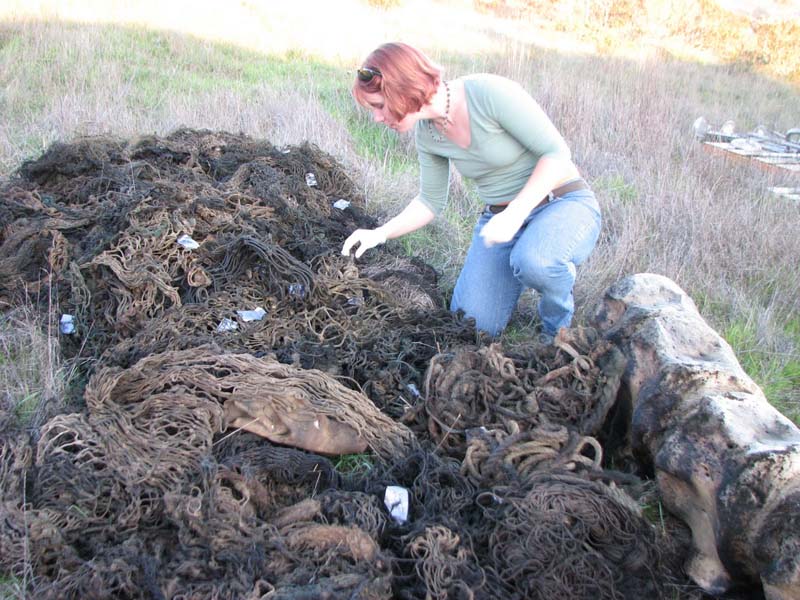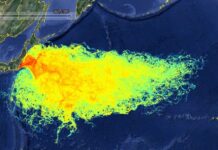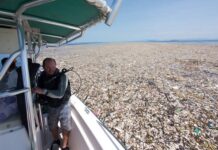How many whales have died as a result of ingesting plastic? Who really knows, but one thing we do know for certain is that the number is quite high, and there is no shortage of examples to prove that.
A couple of months ago, a sperm whale was found dead. Again, it’s not the first time. This one washed ashore after swallowing 64 pounds of plastic debris. He was a male, found in Southern Spain on the Murcian coast. (source)
The EL Valle Wildlife Rescue Center determined that the sperm whale was killed by damaged to the stomach and intestines, by way of gastric shock.
An autopsy was performed, and a slew of nets, ropes, plastic bags and more inside the whale’s stomach and intestines. Once again in case missed above, the picture above is simply a Greenpeace Philippines representation after the sperm whale was found, it’s not actually real.
The intention of the display was to capture the attention of the world.
Whales, and other marine life, have been washing ashore for decades with stomachs full of plastic. Multiple studies have shown that there are unfathomable amounts of plastic and microplastic floating around in the ocean.
These studies also show that a lot of plastic that’s gone into the ocean, is untraceable, meaning that there is some sort of mechanism at play that seems to be removing plastic from the ocean. Who knows if this is true, because these mechanisms have yet to be identified, and a large portion of marine life is probably ingesting these microplastics.
That being said, it wouldn’t be a surprise to find out that Earth has its own cleansing mechanisms, and if so, she’s really being patient with us.
For example, a study published in the Proceedings of the National Academy of Sciences (PNAS) found that at least 88 percent of the Earth’s ocean surface is polluted with plastic debris. The study was conducted by researchers from the University of Cadiz, Spain, as well as the University of Western Australia.
“We can’t account for 99 percent of the plastic that we have in the ocean.” – Carlos Duarte, Professor of Biology at the University of Western Australia, participating researcher in the study.
This is a scary thought, especially given the fact that the plastic we can account for is, already by itself, way too much. Why humanity continues to manufacture products using plastic makes absolutely no sense. We’ve become attached to our ego, and primarily operate for little pieces of paper that don’t really have much value. For the sake of globalization and ‘economic development,’ we’re destroying our planet. We do not need to pollute the Earth in order to advance in an ‘economic’ and ‘global’ agenda, we have so much potential and so many substances, like hemp, that would completely cut pollution down to ZERO.
“One in ten thousand of us can make a technological breakthrough capable of supporting all the rest. The youth of today are absolutely right in recognizing this nonsense of earning a wage.” – Buckminister Fuller
There are also multiple new energy devices showing potential and have been for decades. On a quick side note, there were were over 5,000 inventions that were under secrecy orders at the end of Fiscal Year 2014, which marked the highest number of secrecy orders in effect since 1994. This is all thanks to an act many people are unaware of. It’s called the “Invention Secrecy Act” and it was written up in 1951. Under this act, patent applications on new inventions can be subject to secrecy orders. These orders can restrict their publication if government agencies believe that their disclosure would be harmful to national security.
Here’s the kicker, represented in a quote that gets my point across:
As Steven Aftergood from the Federation of American Scientists reports:
“The 1971 list indicates that patents for solar photovoltaic generators were subject to review and possible restriction if the photovoltaics were more than 20% efficient. Energy conversion systems were likewise subject to review and possible restriction if they offered conversion efficiencies in “excess of 70-80%.” (source)
You can read more about that topic, in a heavily sourced article on patent secrecy HERE.
This is the same reason we have plastic pollution, because of corporate domination and the influence of industry to shut out greener solutions to several of our pollution problems.
So what’s really going on here with regards to whales?
In the summer of July 2013, a sperm whale was stranded on Tershelling, a Northern island in the Netherlands. The whale had swallowed 56 different plastic items that totalled over 37 pounds. In April 2010 a gray whale died after stranding itself on a West Seattle beach; it was found to have over 20 plastic bags, small towels, surgical gloves, plastic pieces, duct tape, and more in its system. And in March of 2013, a dead sperm whale washed up on Spain’s South coast which had swallowed 17kg of plastic waste.
The list goes on and on. Keep in mind, these are only the whales who choose to beach themselves or have washed up on shore; there are surely countless other whales and marine animals suffering the same fate, unbeknownst to us.

Unfortunately, these beachings are not uncommon events. In 1989 a stranded sperm whale in the Lavezzi Islands died of a stomach obstruction after accidentally ingesting plastic bags and 100 feet of plastic sheeting. A paper published in 1990 reports that a sperm whale in Iceland died due to a complete obstruction of the gut with plastic marine debris. In August 2008, a sperm whale washed up dead on the beach near Point Reyes, California, with 450 pounds of fishing net, plastic bags, and rope in its stomach (see picture to the left). In 2008, the California Marine Mammal Stranding Database recorded another sperm whale with enormous amounts of plastic and fish netting in its stomach. (source)
The Great Garbage Patch
The effects of our plastic consumption are becoming more and more visible. By now, you’ve probably heard of “The Great Garbage Patch,” an area the size of Queensland, Australia where there are approximately one million tonnes of plastic congregated in the ocean. Drag a net in any area of this part of the ocean and you will pick up toxic, discarded plastic. We’ve shown this video before, but here it is again, just in case you missed it.
Military Sonar Testing
Despite the fact that this article is about plastic, it’s also about marine life in general, and this is a topic that hasn’t really received enough discussion, so I felt it important to mention.
The United States military has been conducting underwater testing of explosive weapons and sonar devices for some time now. These tests have taken place in the Atlantic and Pacific oceans, including the Gulf of Mexico, and are happening today, having commenced in 2014 and set to run all the way to 2019.
No definitive link has been established between these tests and this particular case, but that doesn’t mean we should rule it out, and while whales have, admittedly, been found beached before such testing took place, we should at least consider whether this military activity is at least a contributing factor. In any case, it certainly doesn’t hurt to create awareness about it.
Sonar testing is, at the very least, doing some real damage. In 2009 Scientific American released an article examining the effects of military sonar testing on marine life, confirming that it can and has led to both injury and death of marine animals. They also note that these animals make every effort to escape the noise:
“Unfortunately for many whales, dolphins and other marine life, the use of underwater sonar (short for sound navigation and ranging) can lead to injury and even death. Sonar systems—first developed by the U.S. Navy to detect enemy submarines—generate slow-rolling sound waves topping out at around 235 decibels; the world’s loudest rock bands top out at only 130. These sound waves can travel for hundreds of miles under water, and can retain an intensity of 140 decibels as far as 300 miles from their source.
These rolling walls of noise are no doubt too much for some marine wildlife. While little is known about any direct physiological effects of sonar waves on marine species, evidence shows that whales will swim hundreds of miles, rapidly change their depth (sometime leading to bleeding from the eyes and ears), and even beach themselves to get away from the sounds of sonar.”
According to National Resource Defense Council (NRDC) policy analyst Michael Jasny, a study published in the Proceedings of the Royal Society B shows that even mid-frequency noises disrupt feeding patterns in baleen whales and could negatively affect entire populations. The NRDC cites multiple mass strandings on beaches after sonar has been used, including 200 beached melon-headed whales in 2004 off the coast of Hawaii — one of many examples.
The Navy is not denying these facts. They have admitted that most of the deaths would come from detonation of explosives, sonar testing, or animals being hit by ships. Although I do not trust Navy estimates, according to their computer models this activity could kill hundreds of whales. The Navy said it developed the estimates by totalling the hours it will test and practice with sonar, torpedoes, missiles, explosives, and other equipment for five years. This testing will be (and already has been) responsible for the death of thousands. According to Green Peace, the government estimates 138,500 whales and dolphins will be injured or killed.
Take action by sending an email to The Honorable Charles T. Hagel, U.S. Secretary of Defense. You can email him at [email protected]. Feel free to use this sample letter provided by PETA. Sign a petition here as well as here.
Solutions?
Our planet is calling on us to change our ways, and the change starts with you. Toxic industrial practices must cease. New, clean, green technology is available and we could easily replace all of these plastics with hemp or other alternatives. We have so many solutions, yet we do not implement them or often times, made aware of them either.
Solutions may include manufacturing plastics with hemp or other biodegradable products. Another example would be developing cleaning technologies, as in the story of 19 year old Boyan Slat, who developed a device with the capacity to remove 7,250,000 tonnes of plastic and garbage from the world’s oceans in just 5 years. Boyan, now 20, and CEO of The Ocean Cleanup Project, has just announced that his project will come into fruition this year. You can read more about that here.
The push for a greener Earth has been around for a long time, but we rely on politicians and ‘world leaders’ to gather and come up with them. The power to change our planet is often given away by ourselves, and as a result, red tape and corporate interest put the planet on the back burner in favour of materialistic gains.
There is a positive note, with all this destruction and lack of compassion for Earth and all life upon it, there is a wide-spread awareness. Activists are being born every day, and with time, our actions will change the world. The movement is only growing in strength.
Not sure where to start? You can volunteer to help clean our environment or even start as simply as cleaning up your own neighborhood. Grab a friend, family or go alone and see how much garbage you can find just in your own area alone. Everything makes an impact. Share your story with others via social media to inspire more actions.
Free Franco DeNicola Screening: The Shift In Consciousness
We interviewed Franco DeNicola about what is happening with the shift in consciousness. It turned out to be one of the deepest and most important information we pulled out within an interview.
We explored why things are moving a little more slowly with the shift at times, what is stopping certain solutions from coming forward and the important role we all play.







Check out number 15 – this is fake news
https://www.troab.com/nothing-happy-about-earth-day/3/
Comments are closed.